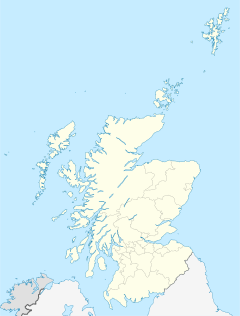Haddo House is a Scottish stately home located near Tarves in Aberdeenshire, approximately 20 miles (32 km) north of Aberdeen (grid reference NJ868347). It has been owned by the National Trust for Scotland since 1979.
| Haddo House | |
|---|---|
 | |
| General information | |
| Location | Near Tarves in Aberdeenshire |
| Coordinates | 57°24′11″N 2°13′13″W / 57.4030°N 2.2204°W |
| Completed | 1732 |
| Owner | The Gordons |
| Design and construction | |
| Architect(s) | William Adam |
| Website | |
| Website | |

Establishment and architectural style
editThe Gordons, who later became the Earls of Aberdeen and Marquesses of Aberdeen, have lived on the site for over 500 years.[1] Haddo House sits in or near the site of the old Kellie Castle, the family's previous dwelling which was burnt down by the Covenanters and dates from 1732;[1] it was designed by William Adam in the Georgian Palladian style. The interior of the house though is late Victorian in style, having undergone refurbishment in 1880 by Wright and Mansfield.[1] Haddo contains a large art collection, including a series of 85 castles by James Giles and an early work by Claude Lorrain.[2] There are also several portraits of 19th-century British politicians.
Dinner Service
editA specially-made display cabinet contains the Cabot Commemorative State Dinner Service. The hand-painted porcelain service with twenty-four settings for an eight-course meal was made by members of the Woman's Art Association of Canada in 1897. The Canadian government declined to pay the CDN$1,000 asking price. It was purchased privately by members of the House and Senate of Canada and presented on 12 June 1898 to Lady Aberdeen on the occasion of her husband ending his term as Governor-General of Canada.[3]
Peripheral buildings
editJohn Smith did the design work for the kitchens and peripheral buildings in 1843. He returned there in 1845 and built the gate houses at the North and South entrances. Constructed in a rough coarse granite, these single storey buildings are in a Tudor style.[4]
Prime ministerial residence
editHaddo House's most notable former resident was George Hamilton-Gordon, 4th Earl of Aberdeen, the British prime minister from 1852–1855.[5]
World War II hospital
editAnother notable period in its history was during World War II when the house became a maternity hospital for the evacuated mothers of Glasgow. Nearly 1200 babies were born at Haddo Emergency Hospital, as it was known, and many still come back to visit known affectionately as the Haddo Babies.[6]
Theatre
editThe house has a small chapel attached. In the grounds is a theatre, Haddo House Hall, and rehearsal rooms, known as the Peatyards. Haddo House Choral & Operatic Society (HHCOS), a large and vibrant choral society formed in 1945, has its operations base there. For over sixty years it has been noted for its annual musical and operatic productions.[7]
Damages by Storm Arwen
editIn 2021, around 100,000 trees were destroyed during Storm Arwen. It is estimated that it will take a generation for the estate to return to its pre-storm way.[8]
References
edit- ^ a b c National Trust for Scotland Archived December 17, 2007, at the Wayback Machine
- ^ aboutaberdeen.com
- ^ "The Cabot Commemorative State Service for Canada, 1897 - A History". Canadian Museum of History. p. 3. Retrieved 14 July 2014.
- ^ Miller, David G. (2007). Tudor Johnny: City Architect of Aberdeen: The Life and Works of John Smith 1781-1852. Librario. p. 348. ISBN 978-1-904440-97-0.
- ^ The Heraldry Society of Scotland
- ^ Search is on for Haddo babies, National Trust For Scotland, June 18, 2010. Accessed January 7, 2012.
- ^ Fraser, Peter (2014) 'OperaScotland' http://www.operascotland.org/person/8203/Haddo+House+C+%26+O+Society Accessed September 20, 2014.
- ^ "Haddo House lost 100,000 trees during Storm Arwen". BBC News. 6 December 2021. Retrieved 7 December 2021.
